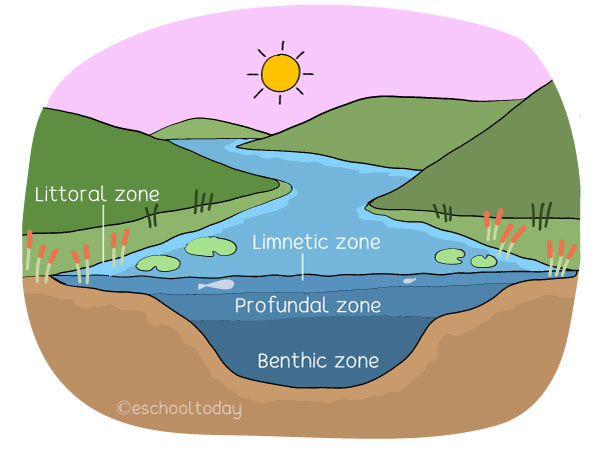- Aquatic Ecosystems
What is a Lentic System?
It includes all non-flowing (still waters) such as ponds, swamps, bogs, lagoons, lakes, and so on. It also includes wetlands (areas of land that get covered with water periodically). Lentic systems usually do not have a source, as they form in places where the groundwater reaches the earth’s surface. Sometimes, water will stay on the earth’s surface due to the saturation of the underlying land. Some lakes and ponds are created by humans for commercial and recreational use.
Animals and plants in a lentic system behave and adapt differently because there are various zones of every lentic system with different abiotic conditions.
The diagram below illustrates the zones of a lentic system.

Littoral Zone:
This zone forms the banks or boundary of the water. There is usually warmer and shallow water, with lots of plants such as reeds and cattails. Many of the plants are rooted in the muddy floor and their leaves form a good hideout for insects and fish. There is a lot of fish, frogs, reptiles, and insects in this zone.
Limnetic Zone:
It is the zone after the Littoral zone, extending a few meters into the water body. Fish swim freely here, with some plants floating on the water. There is enough sunlight here, and algae and plankton usually thrive here.
Profundal Zone:
This zone extends beyond the Limnetic zone and is a deeper region of the water. Here, there is usually very little or no sunlight. It is cooler. Living things in this region depend on drifting organic matter for food.
Benthic Zone:
This is the deepest region of the water body and farthest from the banks. There is no sunlight in this region, and therefore very little or no photosynthesis occurs here. Organisms that live here include worms, bacteria, decomposers, and other scavengers.
Our research for this topic included these sources:
1. An Ecological Profile of the Narragansett Bay National Estuarine Research Reserve
Chapter 10: Nekton, Kenneth B. Raposa
2. Living Organisms in Water, http://www.ku.edu.np/aec/sharmaPDF/M.Sc/AQ/12.pdf Accesses in December 2018
3. Freshwater zooplankton, https://www.doc.govt.nz/nature/native-animals/invertebrates/zooplankton/ accessed in December 2018
4. Phytoplankton Blooms: The Basics. Written by: Nancy Diersing, Florida Keys National Marine Sanctuary. Published: May 2009, https://nmsfloridakeys.blob.core.windows.net/floridakeys-prod/media/archive/scisummaries/wqpb.pdf Accessed in December 2018
5. UNEP, 2015, Blue Economy: Sharing Success Stories to
Inspire Change. www.unep.org/greeneconomy. ISBN: 978-92-807-3502-4
6. Aquatic Ecology And The Food Web, http://agrilife.org/fisheries/files/2013/10/Aquatic-Ecology-And-The-Food-Web.pdf Accessed in December 2018
